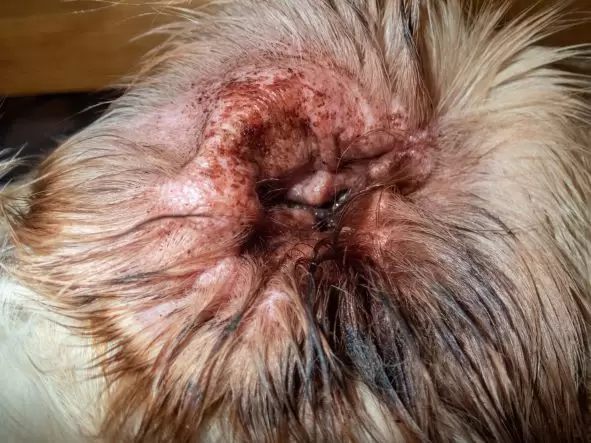Visão geral

General information?
An ear infection is an irritating and painful overgrowth of bacteria or yeasts inside the ear. Most ear infections develop due to an underlying problem such as a skin allergy, ear mites, growths, excessive ear cleaning or wax.
Most ear infections only affect the outer ear canal, but left untreated, an infection can spread deeper down into the middle or inner ear.

What are the symptoms?
Symptoms of an ear infection include:
Middle and inner ear infections also often cause:

Quando entrar em contato com seu veterinário?
Contact your vet for an appointment ASAP if you suspect your dog has an ear infection – it’s a very painful problem that needs prompt treatment. If you notice any signs of a middle or inner ear infection (loss of balance/head tilt), this is more serious and requires a same-day appointment. Be sure to tell your vet if your dog has regular ear infections or has had more than 2-3 in its lifetime.
Tratamento?
Your vet may want to look at a discharge sample from the infected ear to find the cause, and then recommend some of the following:
Important: Never use cotton wool buds to clean your dog’s ears, use cotton wool pads, and don’t push them inside the ear.
Outlook?
If your dog’s ear infection is caught and treated early, it will probably clear up quickly. You will need to take your dog back for a check-up to make sure it has completely resolved.
What if it doesn’t improve?
If your dog’s ear isn’t getting better, your vet may decide to examine or treat it under anesthetic. Some ear infections require several weeks of treatment. In some more severe cases, surgery is necessary because the infection continues for so long that the ear becomes misshapen.
Ongoing care?
Ongoing ear care is important for dogs that suffer from ear infections.
How to clean your dog’s ears?
Watch this video for tips and advice on cleaning your dog’s ears. Remember to use a good quality ear cleaner for dogs.
Custo?
Ear infections can be expensive to manage, especially if they keep coming back. It’s important to speak to your vet openly about your finances, the cost of treatment, as well as what you think is right for your dog. There may be more than one treatment option, so if one doesn’t work for you and your pet, your vet may be able to offer another.
A priorização do seguro para cães a partir do momento em que você traz seu companheiro canino para sua vida é altamente recomendado. Essa abordagem proativa garante que você tenha o apoio financeiro vital necessário para atender a todas as necessidades de saúde do seu cão.

| Biscoito | Duração | Descrição |
|---|---|---|
| cookielawinfo-checkbox-analítica | 11 meses | This cookie is set by GDPR Cookie Consent plugin. The cookie is used to store the user consent for the cookies in the category "Analytics". |
| cookielawinfo-checkbox-funcional | 11 meses | The cookie is set by GDPR cookie consent to record the user consent for the cookies in the category "Functional". |
| cookielawinfo-checkbox-necessário | 11 meses | This cookie is set by GDPR Cookie Consent plugin. The cookies is used to store the user consent for the cookies in the category "Necessary". |
| cookielawinfo-checkbox-outros | 11 meses | This cookie is set by GDPR Cookie Consent plugin. The cookie is used to store the user consent for the cookies in the category "Other. |
| cookielawinfo-checkbox-desempenho | 11 meses | This cookie is set by GDPR Cookie Consent plugin. The cookie is used to store the user consent for the cookies in the category "Performance". |
| view_cookie_policy | 11 meses | O cookie é definido pelo plug-in GDPR Cookie Consent e é usado para armazenar se o usuário consentiu ou não com o uso de cookies. Não armazena nenhum dado pessoal. |